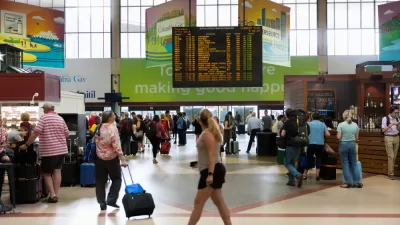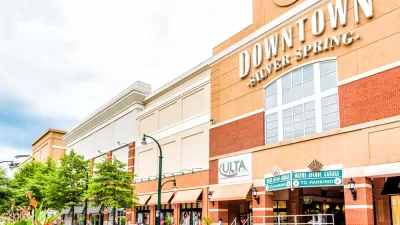After plans to create a transit-oriented, pedestrian-friendly district in the Austin suburb of Leander fizzled due to the recession, the city has cut back minimum height and density requirements in the hopes of attracting more investment.
"After months of discussion and several tense town hall meetings, the Leander City Council voted Thursday evening to shrink the zone requiring high density development around the town’s MetroRail station to a little more than a third of its original size," reports Esther Robards-Forbes.
"The overall size of the 2,300-acre, transit-oriented development district hasn’t changed, but the zone designated for high-density, pedestrian-friendly shopping and housing developments has shrunk from more than 1,300 acres to just 520 acres."
As for the unmet expectations that preceded the city's recent moves, Robards-Forbes reports: "For a decade…much of the land has sat empty...Landowners said that developers and builders, particularly the big box stores that had shown interest, were being scared off by heavy restrictions such as minimum height and density requirements. In the areas closest the station, buildings had to be a minimum of two stories and residential buildings were limited in favor of commercial and retail."
FULL STORY: Leander shrinks high-density zone around MetroRail station

Trump Administration Could Effectively End Housing Voucher Program
Federal officials are eyeing major cuts to the Section 8 program that helps millions of low-income households pay rent.

Planetizen Federal Action Tracker
A weekly monitor of how Trump’s orders and actions are impacting planners and planning in America.

Ken Jennings Launches Transit Web Series
The Jeopardy champ wants you to ride public transit.

Washington Legislature Passes Rent Increase Cap
A bill that caps rent increases at 7 percent plus inflation is headed to the governor’s desk.

From Planning to Action: How LA County Is Rethinking Climate Resilience
Chief Sustainability Officer Rita Kampalath outlines the County’s shift from planning to implementation in its climate resilience efforts, emphasizing cross-departmental coordination, updated recovery strategies, and the need for flexible funding.

New Mexico Aging Department Commits to Helping Seniors Age ‘In Place’ and ‘Autonomously’ in New Draft Plan
As New Mexico’s population of seniors continues to grow, the state’s aging department is proposing expanded initiatives to help seniors maintain their autonomy while also supporting family caregivers.
Urban Design for Planners 1: Software Tools
This six-course series explores essential urban design concepts using open source software and equips planners with the tools they need to participate fully in the urban design process.
Planning for Universal Design
Learn the tools for implementing Universal Design in planning regulations.
Heyer Gruel & Associates PA
Ada County Highway District
Institute for Housing and Urban Development Studies (IHS)
City of Grandview
Harvard GSD Executive Education
Toledo-Lucas County Plan Commissions
Salt Lake City
NYU Wagner Graduate School of Public Service





























